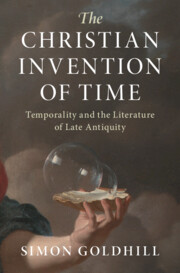Book contents
- The Christian Invention of Time
- Greek Culture in the Roman World
- The Christian Invention of Time
- Copyright page
- Contents
- Acknowledgements
- Abbreviations of Ancient Sources
- Introduction
- Part I
- Chapter 1 God’s Time
- Chapter 2 The Time of Death
- Chapter 3 Telling Time
- Chapter 4 Waiting
- Chapter 5 Time and Time Again
- Chapter 6 Making Time Visible
- Chapter 7 At the Same Time
- Chapter 8 Timelessness and the Now
- Chapter 9 Life-times
- Chapter 10 The Rape of Time
- Part II
- Coda
- Bibliography
- Index Locorum
- Subject Index
Chapter 7 - At the Same Time
from Part I
Published online by Cambridge University Press: 13 January 2022
- The Christian Invention of Time
- Greek Culture in the Roman World
- The Christian Invention of Time
- Copyright page
- Contents
- Acknowledgements
- Abbreviations of Ancient Sources
- Introduction
- Part I
- Chapter 1 God’s Time
- Chapter 2 The Time of Death
- Chapter 3 Telling Time
- Chapter 4 Waiting
- Chapter 5 Time and Time Again
- Chapter 6 Making Time Visible
- Chapter 7 At the Same Time
- Chapter 8 Timelessness and the Now
- Chapter 9 Life-times
- Chapter 10 The Rape of Time
- Part II
- Coda
- Bibliography
- Index Locorum
- Subject Index
Summary
To stand in Rome before the Pantheon and stare up at the huge bronze letters of the domineering inscription M. AGRIPPA L F COS TER FECIT is to recognize the memorializing power of the ancient epigraphic habit – and the degree to which the ancient city was full of sites that made the past physically, visibly present. The Parthenon parades its anonymity, proud in its generalization of the democratic ideal: the Pantheon broadcasts its maker’s name. Even or especially here, however, the act of making memory visible turns out to be more complicated than it might at first seem. The temple itself, originally built by Agrippa, had been burnt down twice, and the second rebuilding was completed by Domitian, an emperor so despised by those who remembered him that his statues were said to bleed and scream (it will be remembered) when beaten in violent damnatio. There is no record of his name on the Pantheon. This facade was rebuilt by Hadrian, who nonetheless has also not left his name anywhere on the building. This may seem an act of surprising restraint, but later history (HA Hadrian 20.3) records that Hadrian did not care to have his name proclaimed on buildings that he established or restored (though he was happy for cities to be named after him).
- Type
- Chapter
- Information
- The Christian Invention of TimeTemporality and the Literature of Late Antiquity, pp. 132 - 155Publisher: Cambridge University PressPrint publication year: 2022



